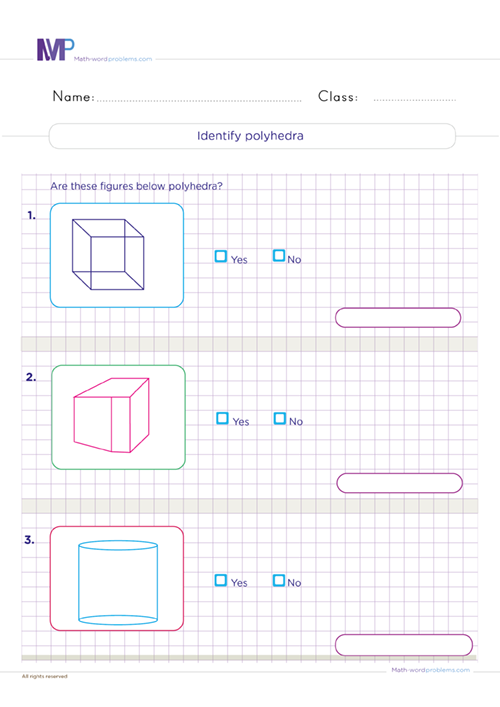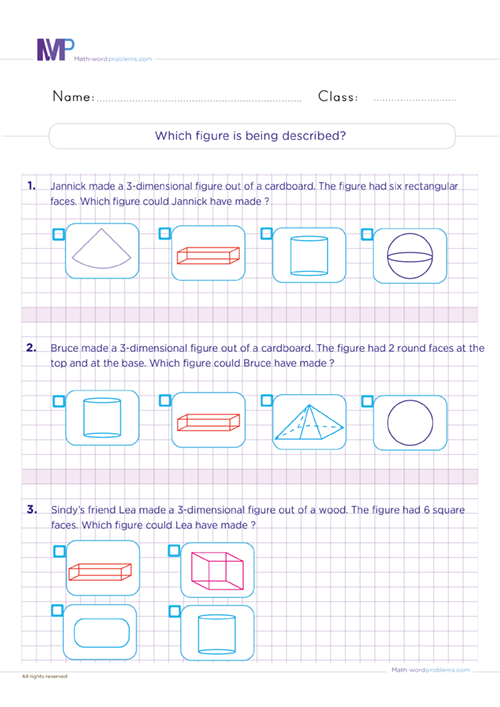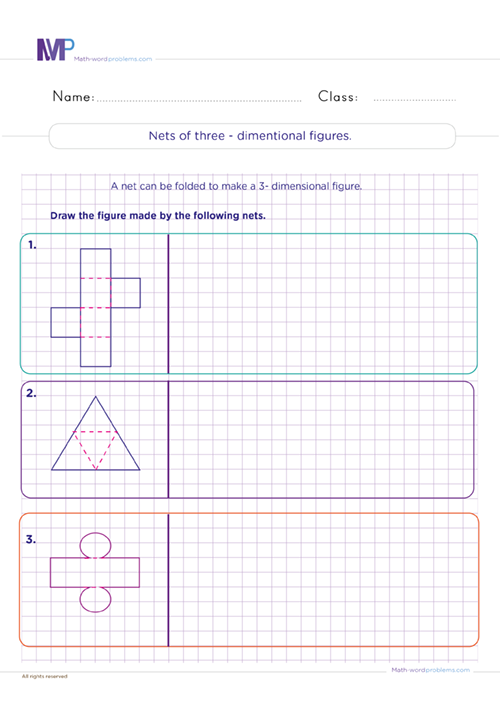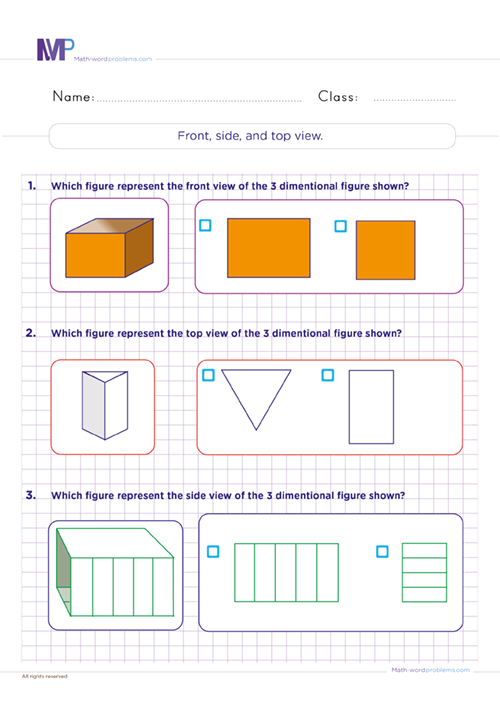 Three-dimensional figures worksheets Grade 6
Three-dimensional figures worksheets Grade 6

- INTRODUCTION
- Download worksheets
- Related Contents
- Properties and examples of three-dimensional figures workshe...
Get more contents on Three dimensional figures Grade 6...
Test your 6th grader's solving 3-D shapes skills with our super fun three-dimensional figures worksheets Grade 6. From its name, 3-dimensional shapes are solid shapes with three dimensions, i.e., length, width, and depth. We call them solid shapes because they occupy space and have volume. Some examples of such shapes include; cubes, spheres, cones, cylinders, pyramids, prisms, etc. However, we will provide remarkable 3-D figure worksheets to help you learn more about types of three-dimensional figures, their properties, and how to identify them from different views.
In addition, another fun technique for kids to understand 3-D shapes better is by describing them using faces, Edges, and Vertices and the front, side, and top views worksheets. You see these views when looking at the shape from different directions. For instance, looking at a cube from the front, you will see a square. Looking at it from the side, you will see another square. Looking at it from the top, you will see yet another square.
Most importantly, we hope to captivate your 6th grader's interest in these worksheets by designing nets of 3D shapes exercises. This worksheet will offer them the techniques of folding flat shapes to make different 3-dimensional shapes. As kids enjoy folding these shapes, they will likely understand geometry better while applying its skills to real-life situations.
Nets of 3D shapes worksheet 6th grade
Encourage your kids to practice solving these fun, remarkable nets of 3D shapes worksheet 6th grade, where they will practice identifying, folding, and making different 3-dimensional shapes. As much as this worksheet stimulates kids' 3D shapes solving skills, they will understand that a three-dimensional shape comprises two-dimensional components and is essential to engineers and designers who design many things in our society.
For a better understanding, a net of a 3D shape is what a particular 3D shape can look like if opened out flat. In this resource, however, we will provide flat or open shapes for kids to learn how to fold them to make a 3D shape. One thing to note is that there may be several possible nets for one 3D shape.
With this in mind, we will provide unique three-dimensional figures worksheets Grade 6 consisting of several nets designed with dotted lines so you can keenly visualize and fold them along these dotted lines. Once you complete folding (drawing) the net, you'll be amazed at the result, i.e., the solid shape you designed from the net. To make this concept more interesting, you can draw a net on a piece of paper in the comfort of your home and cut and fold it into its desired shape.
Nevertheless, we cannot understand nets of 3D shapes practice if we do not master their properties and meaning. So what do we understand by faces, edges, and vertices in 3D shapes?
Properties and examples of three-dimensional figures worksheets Grade 6
6th graders need to master the properties and examples of three-dimensional figures worksheets Grade 6 to strengthen their understanding of all 3D shapes' properties. The main properties of 3D shapes are faces, edges, and vertices. In this resource, however, we will learn about the properties of basic solid shapes like cubes, prisms, pyramids, cylinders, cones, and spheres. To identify the properties of each shape, note that;
-
The face is the flat surface of any three-dimensional shape. Apart from the sphere with only 1 face, all solid figures have more than one face. For instance, cubes have 6 faces; cylinders have 3 faces; cones have 2 faces, etc.
-
The edge is the line segment where two faces meet. We can also say that it is the line segment joining two vertices. Some shapes and number of edges include: Spheres have no edge, cubes have 12 edges, cylinders have 2 edges, cones have 1 edge, etc.
-
The vertex is a point where two or more edges meet. We can also say that vertices are the corner points. Some common shapes and number of vertices are: Spheres have no vertex, cubes have 8 vertices, cylinders have no vertex, cones have 1 vertex, etc.
To conclude, you'll bear with me that 3D shapes are everywhere around us. They are used to model objects, buildings, structures, patterns, etc. Thus, by practicing with our three-dimensional figures worksheets Grade 6, you'll strengthen your spatial reasoning skills, which are essential for solving problems involving shapes, measurements, angles, transformation, etc. You can also use your knowledge of 3D shapes to create art, design products, play games, and have excess fun.






